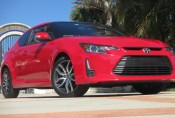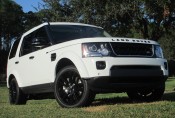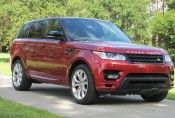2014 Mitsubishi Outlander GT S-AWC
It’s do-or-die time for Mitsubishi here in the U.S. and it’s on the SUV side where the company is seeing the majority of their sales. So will this 2014 Outlander be the vehicle that brings them back to relevancy?
Outselling their cars by a significant percentage, Mitsu – who is in the midst of reinventing itself as a small, efficient-minded car maker – is still relying on the Outlander and Outlander Sport as their all-star sales performers. Still a very small player in the segment, this redesigned 7-passenger Outlander has been given national TV ad dollars to remind people of its existence. And I’m one to root for the underdog in this business but if Mitsu isn’t careful this could turn into another Isuzu story.
And though there are significant improvements in interior quality, more passenger room and a bump in fuel economy the 2014 Outlander is far from a huge advancement. Exterior dimensions are the same and in the this top trim GT model, so is the 3.0-liter SOHC V6 – except it makes less horsepower now, down to 224 while its 215 pound-feet of torque remains. Combined gas mileage rises from 21 to 23mpg thanks to aerodynamic improvements, a body that weighs 200 pounds less and a 6-speed auto with a less aggressive final gear ratio. There’re also 2 new Eco modes – one for the engine and AC and another for the all-wheel drive system that essentially makes the Outlander a 2-wheel drive vehicle. But while its EPA rating of 20mpg city/28mpg highway is better than any V6-powered 4WD I can think of, its power is merely adequate. And in its eagerness to save gas, the transmission is often in a rush to upshift causing a lot of drivetrain busyness. It does make some nice sound when you step on it and feels fairly lively when pushed hard. But the fact that Mitsu still wants premium gas to get it done will be heard with a thud amongst its value-minded shoppers.
With 8.5” of ground clearance and a trick all-wheel drive system, the outlander will appeal to small SUV shoppers looking for a little more latitude.
Mitsu’s Super All Wheel Control system is the Outlander’s piece de resistance, with Eco, Normal, Snow and Lock modes. It’s lighter than before and uses an active front differential with a new brake control feature which applies brake pressure on the inner wheel for improved control in turns. Paired with new electric steering and numerous suspension changes at all 4 corners, the Outlander has respectable on and off-road handling capabilities though the increased stiffness results in a sometimes harsh and unsophisticated ride quality. Highway manners are a bit crude and loud as well.
Inside, the lacking quality of the last model has been cleaned-up with softer touch materials and richer leather though the overall design still feels years behind. Cargo room has shrunk some in favor of more people space which is ample for 5 and a little tight for 7. The 3rd row is now standard and can be accesses through both sides via a sliding 2nd row seat…but it’s not easy. And when it comes time to configure for hauling space, the antiquated system of having to move all 3 rows to make room, flip up seat bottoms and removable headrests – some of which have nowhere to go – is a sign of a company out of touch with American car buyers’ expectations.
Perhaps as expected from an electronics giant, the best part of the Outlander’s interior is the infotainment unit – thorough, easy to use and sharp looking, the navi comes part of the extensive $6,100 GT Touring Package full of leading electronic safety aids, a sunroof, a hard hitting 9-speaker Rockford Fosgate sound system, Sirius, a power driver’s seat, wood grain trim, leather and a power tailgate. No blind spot detection, however.
A 4-cylinder ES FWD starts at $23,820 while this loaded GT S-AWC V6 comes in at $34,720; an affordable price point for a 3-row SUV though likely not the savior the company needs.

 2015 SCION tC QUICK TAKES
2015 SCION tC QUICK TAKES 2014 LAND ROVER LR4 QUICK TAKES
2014 LAND ROVER LR4 QUICK TAKES 2014 RANGE ROVER SPORT QUICK TAKES
2014 RANGE ROVER SPORT QUICK TAKES